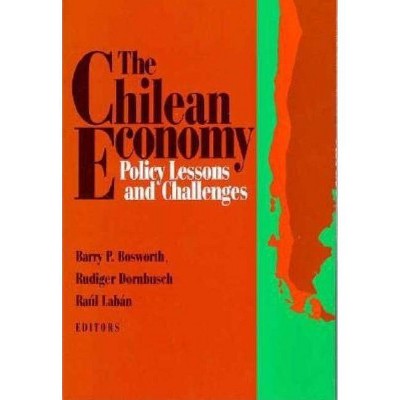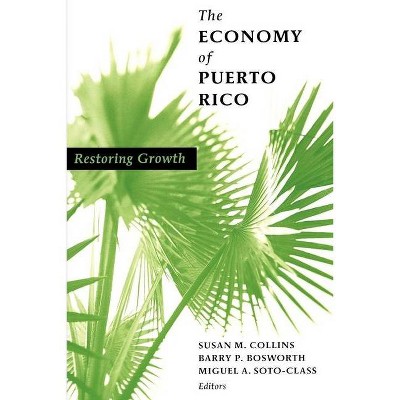The Chilean Economy - by Barry P Bosworth & Rudiger Dornbusch & Raúl Labán (Paperback)

Similar Products
Products of same category from the store
AllProduct info
<p/><br></br><p><b> About the Book </b></p></br></br><p>Should countries in Latin America and Eastern Europe follow the Chilean approach to economic restructuring, market liberalization, and stabilization? Following years of hyperinflation and domestic turmoil, Chile undertook a series of dramatic economic reforms. Chile has also served as a social laboratory for such policies as privatization and social security reform that are of interest to both developed and developing economies. Having implemented much of the original reform program and emerging in the 1990s with a new democratic government, Chile also raises interesting questions about what comes next in its policies to promote growth.</p> <p>The advent in the 1990s of Chile as a model for economic reform is something of a surprise. Many of the reforms were actually introduced in the 1970s, and for a number of years many seemed to have failed to achieve their primary objectives. The more recent, positive view of the Chilean experience results from developments after 1983. Since then, the Chilean economy has grown robustly. What remains controversial is the question why the benefits of the reforms took so long to emerge.</p> <p>In this book, international scholars review the reforms in Chile and assess their effectiveness. They evaluate stabilization policy, economic growth, privatization, reform of the social security system, and the politics of economic reform. Now that many of the original reforms have been largely completed, and Chile has maintained a coherent macroeconomic policy with slowly declining inflation, the authors prescribe what Chile must do to sustain growth in the future.</p> <p>In addition to the editors, contributors include Eduardo Bitran, University of Chile; Vittorio Corbo, Catholic University of Chile; Peter Diamond, MIT; Sebastian Edwards, University of California, Los Angeles, and the World Bank; Stanley Fischer, MIT; Felipe Larrain B., Catholic University of Chile; Mario Marcel, IDB; Manuel Marfán, CIEPLAN; Raúl E. Sáez, CIEPLAN; Andr<p/><br></br><p><b> Book Synopsis </b></p></br></br><p>Should countries in Latin America and Eastern Europe follow the Chilean approach to economic restructuring, market liberalization, and stabilization? Following years of hyperinflation and domestic turmoil, Chile undertook a series of dramatic economic reforms. Chile has also served as a social laboratory for such policies as privatization and social security reform that are of interest to both developed and developing economies. Having implemented much of the original reform program and emerging in the 1990s with a new democratic government, Chile also raises interesting questions about what comes next in its policies to promote growth.</p> <p>The advent in the 1990s of Chile as a model for economic reform is something of a surprise. Many of the reforms were actually introduced in the 1970s, and for a number of years many seemed to have failed to achieve their primary objectives. The more recent, positive view of the Chilean experience results from developments after 1983. Since then, the Chilean economy has grown robustly. What remains controversial is the question why the benefits of the reforms took so long to emerge.</p> <p>In this book, international scholars review the reforms in Chile and assess their effectiveness. They evaluate stabilization policy, economic growth, privatization, reform of the social security system, and the politics of economic reform. Now that many of the original reforms have been largely completed, and Chile has maintained a coherent macroeconomic policy with slowly declining inflation, the authors prescribe what Chile must do to sustain growth in the future.</p> <p>In addition to the editors, contributors include Eduardo Bitran, University of Chile; Vittorio Corbo, Catholic University of Chile; Peter Diamond, MIT; Sebastian Edwards, University of California, Los Angeles, and the World Bank; Stanley Fischer, MIT; Felipe Larrain B., Catholic University of Chile; Mario Marcel, IDB; Manuel Marfán, CIEPLAN; Raúl E. Sáez, CIEPLAN; Andrés Solimano, the World Bank; Andrés Velasco, New York University; and Salvador Valdés-Prieto, Catholic University of Chile.</p><p/><br></br><p><b> From the Back Cover </b></p></br></br>In this book a prominent group of international scholars review the history of economic reform in Chile and assess the effectiveness of its policies. This information encompasses not only the successful approaches that turned around the Chilean economy, but also the significant mistakes that raised transition costs along the way.<p/><br></br><p><b> Review Quotes </b></p></br></br><br><P>"A must for applied international economists, development specialists, policymakers, reformers, and all those who want an excellent read about a country experience that illustrates at its best the complex interface between finance and development." -- "Finance & Development"<br><p/><br></br><p><b> About the Author </b></p></br></br><p> <b>Barry Bosworth </b> is a senior fellow and Robert V. Roosa Chair in International Economics at the Brookings Institution. <b>Rudiger Dornbusch</b> is Ford International Professor of Economics at the Massachusetts Institute of Technology. Raúl Labán is an economist at CIEPLAN, a nonprofit research institution based in Chile. <b>Raúl Labán </b>is an economist at the Ministerio de Hacienda in Chile.</p>
Price History
Price Archive shows prices from various stores, lets you see history and find the cheapest. There is no actual sale on the website. For all support, inquiry and suggestion messagescommunication@pricearchive.us




















